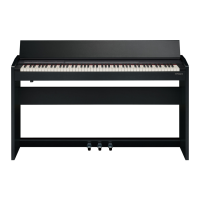Rear
Settings for items with this icon
are saved by Memory Backup
(p. 11).
Bottom
Front Panel
* For details on how to use the other buttons, refer to “Operation Guide” (p. 2)–(p. 7).
Panel Descriptions
[L] Switch
This turns the power on/o (p. 10).
With the factory settings, the unit’s power will
automatically be switched o 30 minutes after
you stop playing or operating the unit.
If the unit’s power has been turned o
automatically, you can use the [L] switch to turn the unit back on again. If you
don’t want the power to turn o automatically, change the “Auto O” setting to
“OFF” as described on “Making the Power Automatically Turn O After a Time
(Auto O )” (p. 13).
About the Display
This indicates the tone number, song number, measure number, tempo, selected
function, or value.
Tone
number
Piano
1
Other
1
Tempo
108
Measure number
1.
Song
number
Internal song
a.01
c.01
User
U.01
USB ash
Drive
N.01
Rhythm
1-1
Adjusting the Volume and Balance (Volume Buttons)
Overall Volume
Use the Volume buttons to adjust the volume.
Volume Balance Between Song/Rhythm and the Keyboard (Song Balance)
While holding down the
[Song] button or [Rhythm]
button, use the Volume
buttons to adjust the
balance.
Relative Balance of Dual Tones (Dual Balance)
This is available if Dual is on.
While holding down the
[Piano] button and [Other]
button, use the Volume
buttons to adjust the
balance.
Relative Balance of Split Tones (Split Balance)
This is available if Split is on.
Hold down the [Split]
button and use the Volume
buttons to adjust the
balance.
g 1
(Song is louder)
1 g
g g
(Same volume)
– –
Volume of the song – Volume of the manual performance
(Manual performance
is louder)
g 1
(Piano is louder)
1 g
g g
(Same volume)
– –
Volume of the piano sound – Volume of the other sound
(Other is louder)
g 1
(Left-hand is
louder)
1 g
g g
(Same
volume)
– –
Left-hand volume – Right-hand volume
(Right-hand is louder)
Headphone Hook
Whenever you
are not using the
headphones, you
can hang them on
the headphone
hook.
Damper pedal
Use this pedal to sustain the sound. While this pedal is held down, notes will be sustained for an extended time even
if you release your ngers from the keyboard. The length of the sustain will change subtly depending on how deeply
you press the pedal. On an acoustic piano, holding down the damper pedal will cause the strings for notes other
than the ones you actually play to vibrate in sympathy with what you’ve played, producing a rich resonance. This
unit simulates this sympathetic vibration (damper resonance).
Sostenuto pedal
This pedal sustains only the notes of the keys that were already pressed when you pressed the pedal.
Soft pedal
This pedal is used to make the sound softer. Playing with the soft pedal depressed produces a sound that is not
as strong as when otherwise played with the equivalent strength. This is the same function as the left pedal of an
acoustic piano. The softness of the tone can be varied subtly by the depth to which you press the pedal.
8

